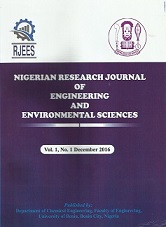Heat Exchanger Network Optimization for Atmospheric Crude Oil Distillation
Authors: Igbagara, P.W. And *Adeloye, O.M.
DOI Info: http://doi.org/10.5281/zenodo.15778228
ABSTRACT
Heat integration, conservation and optimization in refinery operation are pertinent aspects of crude oil refining. The study focused on the integration effects of heat exchanger arrangements and network structures both in series and parallel on total heat utilization or consumption and optimization in an atmospheric crude oil distillation. The overall heat optimization model for the two networks was based on the Chen’s Approximation, which yielded reasonably close results between the Aspen HYSYS model and analytical model computations using MATLAB simulator. The models in this study also demonstrated clearly the graphic advantage of the parallel exchanger network over the series exchanger network structure. The Chen’s approximation model applied in this study yielded minimum heat requirement of 19313kJ/h and 18950kJ/h for Aspen HYSYS and MATLAB software simulations respectively. The results gave a percentage minimum deviation or percentage absolute error value of 2.1%, which is within the acceptable absolute or deviation limit range. The optimum heat requirement for both series and parallel heat exchanger arrangements are 451.8192kJ/h and 150.6064kJ/h respectively.
Affiliations: Department of Chemical Engineering, Federal University Otuoke, Otuoke, Bayelsa State, Nigeria.
Keywords: Heat Integration, Parallel, Series, Chen’s Approximation, Optimization
Published date: 2025/06/30









